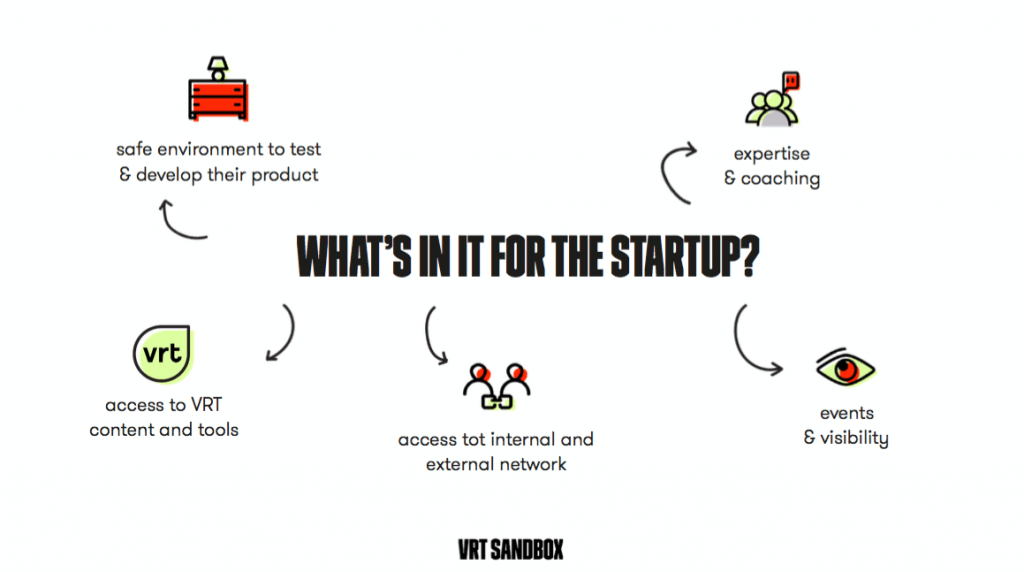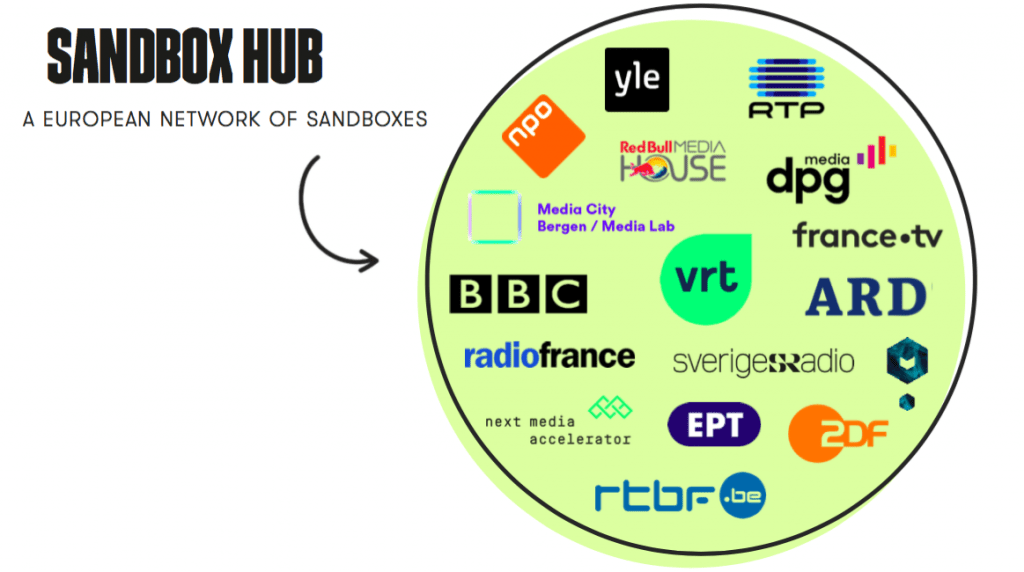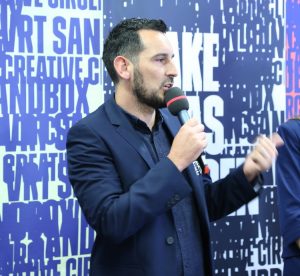VRT Sandbox: leading the way on startup and media collaboration in Europe
VRT’s remit is technically limited to the 6.5 million Dutch speakers of northern Belgium – but the public-service broadcaster has spent years going above and beyond in the name of media innovation.
VRT Sandbox, one of a number of its innovation brands, has for five years been acting as a “front door for startups and scale ups in media”, according to its head Peter de Paepe, a former radio producer and presenter.
“Everybody who thinks that it might be interesting to work with VRT can just knock on the door and say ‘OK, this is who I am and I would like to work together with you, with this brand’”, he explains. “And of course, as a company, we’re glad that we can work with the most promising media startups.”
After getting lots of approaches from startups and scaleups keen to test their content or tech solutions, de Paepe set up a ‘matchmaking’ service. Now, he sits down with more than 100 companies each year, as well as staff from VRT’s 11 TV, radio and OTT brands, to understand what each would want from a match.
“We offer startups a test for three to four months. Why? Because it’s very clear. It’s very short. It is doable for the brand on the VRT side and for the startup. That also means sometimes you have to define a use case that’s rather basic. So that’s a bit of a challenge.”
In other organisations, this kind of collaboration might take four to six months to get started, once you get your foot in the door, of course. But VRT Sandbox aims to get started in four to six weeks.
“We identify what a startup is doing. Then we try to figure out, ‘OK, what can it mean for the brands that we have?’. Then we organise ‘dating’ and give an MOT to the brands. The startup needs to have something that works and can be implemented right away.”
Matchmakers, not project makers
Every year up to 20 companies, half Flemish, half international, that are working in media content, tech or edtech test a minimum-viable product with one of VRT’s teams, a workforce of 2,000. One such match has seen startups working with Studio Brussels, VRT’s youth radio channel, on an end-of-year multimedia event that reaches more than 1 million people every day.
Alongside a specific call in the “difficult” area of edtech, which supports VRT’s wider strategic goal to get good content into education, VRT is on the hunt for companies working on ‘interaction and co-creation’, ‘personalisation, data and A.I’, ‘fighting fake news’ and ‘accessibility’. The latter is another key focus for the public-service broadcaster, designed to help it reach every Flemish person.
“We are not project makers. We link the startup to a brand, and then, if we have found the right use case and the right match, it’s the people of the brand and the startup that work together. And we are just in between to guide it a little bit.
“That also means sometimes we see things falling apart. But we are not there to always convince people to further work on these projects.”
The Sandbox has a physical space where startups can base themselves and where VRT staff can make suggestions for new projects. “That works very well and it’s very nice to see that we are sort of a central innovation place where all of the brands come and know, ‘OK, this is where we can discuss new plans with startups’.”
Closed wallet
VRT Sandbox operates a ‘closed wallet’ model – startups don’t get cash, but they get experience in a ‘safe environment’, expert coaching, exposure and, sometimes, a deal with VRT – or, even, help getting their next paid gig.
“The startups have access to our internal network, not only people, but they also get to see how we work and our technological stack. That’s also a reason why they are very keen to come.
“And you have the dissemination. That means that we try to see, after four months, ‘what did we learn? Can we spread the things that we learned?’. We question the people very well on the VRT side and startup side to understand ‘what did they learn and what do they want to do after this?’.”
To further amplify this, de Paepe’s team runs two large events each year – one for the local media circuit and one, integrated into Media Fast Forward, that hosts 2,000 participants from across Europe and offers a ‘startup street’ showcase for more than 60 companies. Along with offering startups the opportunity to travel to other events across the world, this takes the bulk of his €160,000 yearly budget, plus a small team, equivalent to four full-time workers.

One successful Sandbox project, Theoplayer, has become the default media player across all VRT’s websites. “They tested four years ago with a minimum-viable product. They are now a company with about 120 people and have offices in New York and San Francisco.”
Startups changing media practice
Another, Voizupp, has created fundamental change at the broadcaster by offering an app-based integration, alongside a data dashboard that, for the first time, enables radio teams to see who’s listening, for how long, and more, so they can take that data into the discussions around the shows they make.
“Sometimes people say, ‘you’re always testing with startups, and on a very small scale – what is the importance for a big company as VRT?’. And then I give them the example of Voizupp, how you can make not only the technological change, but also a change in minds, how people make their radio programmes or TV programmes.
“And, of course, you have to accelerate with other teams and then say, ‘OK, how can we find a budget to make it bigger?’. But the start comes from or can come from a startup. So that’s why I think that often it works very well.”
After two years testing with Flemish startups, and with international interest coming in, de Paepe decided to see about making the Sandbox bigger – and is now focused on being able to offer startups and scaleups the chance to truly go global.
“OK, can we reproduce this model to other media companies?,” he asked. “We went to the BBC and Media City Bergen and Red Bull Media House. We explained how we work and why we thought it was a good idea. And, actually, they decided very fast to do it. It’s not an exact copy, but the idea of innovating together with startups and scaleups, learning very fast and sharing this expertise. That’s what these companies do.”
Scaling up the opportunity
They now have 18 public and private media companies in the Sandbox Hub, who meet monthly to share what they’re learning. “Almost every country in Europe is represented. After a startup collaboration with VRT, we introduce startups to another media party like NPO [the Dutch public broadcaster]. And then they do a test there or they just get a paid introduction and then they are launched European.”

The final piece of the puzzle, it seems, was found just over a year ago with the creation of a €10 million, joint-venture innovation fund, Media Invest Vlaanderen [Media Invest Flanders], with local investment firm PMV.
“Of course, a fund is a new way of bringing cash in for VRT. But the main reason we thought it was a good idea was because, if these startups wanted to grow internationally, they would need investment money to grow.
“If you compare it with fintech, for example, there, it’s very easy to find money, but in media, it’s rather difficult to find €1 million. So this is a fund that can help them. It’s mainly for professionalising the ecosystem. The last one we funded is actually Theoplayer. They had a round of €6 million and we put it in €1 million.”
So why is a public-service broadcaster from the north of Belgium so keen on building a stronger media innovation ecosystem across Europe?
“It’s something that is in our DNA. We really want to be one of the most innovative media companies of Europe. The fact that we are very central and that we have to network is, of course, one of the things that we are doing already for 30, 40 years. So that’s nothing new.
“What is new is that we, from a perspective of the startups, for them it was very important to immediately work in an international environment. And that meant that we had to, for example, communicate in English. That sounds very easy. But we had to struggle to make that happen.”
He’s also very keen to make sure Europe has the companies it needs to compete with the US and Asia.
And, while de Paepe admits this innovation work hasn’t, so far, spurred a huge increase in the number of local media startups, VRT’s approach is sought after in more unexpected places.
“A lot of other companies, and not only media companies, are coming and looking to us, for example, the national lottery company and BPost, the company that delivers the post in Belgium. So what I see is that people are now more and more convinced that the way that we innovate might be a useful way to innovate. We never pretend that’s the only one way, or the only good way. We just explain how we do it.”
CONTACT

Peter de Paepe, head of VRT Sandbox
Twitter: @peterdepaepe
